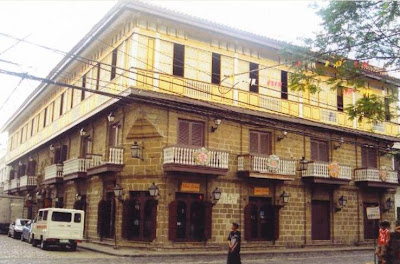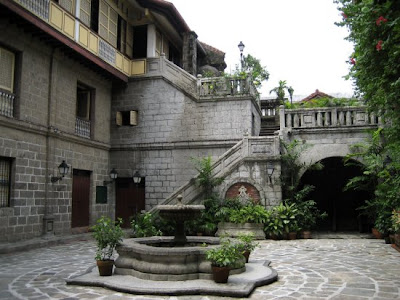 Intramuros or the walled city of Manila, is located along the southern bank of the Pasig River close to the rivers entrance into Manila Bay. Intramuros was the old capital of Manila, served as the center of political, military and religious power of the Spaniards during the time that the Philippines were a colony of Spain. Constructed in 1571, during the period of Spain’s colonization of the Philippines. Its name, in Spanish, intramuros, literally "within the walls", meaning within the wall enclosure of the city/fortress, also describes its structure as it is surrounded by thick, high walls and moats.
Intramuros or the walled city of Manila, is located along the southern bank of the Pasig River close to the rivers entrance into Manila Bay. Intramuros was the old capital of Manila, served as the center of political, military and religious power of the Spaniards during the time that the Philippines were a colony of Spain. Constructed in 1571, during the period of Spain’s colonization of the Philippines. Its name, in Spanish, intramuros, literally "within the walls", meaning within the wall enclosure of the city/fortress, also describes its structure as it is surrounded by thick, high walls and moats.The walled city covers an area of about 160 acres. Intramuros was a fortress city with walls 6 metres high and a commanding 3 kilometres in length, it is no wonder it was impenetrable. Intramuros was designed with 51 blocks within the vast walls, the only access in or out of Intramuros was via seven fortified gates. A moat around the walled city was added in 1603. Spread throughout the 51 blocks of the city were 12 churches, hospitals, domestic accommodation, military barracks, Governors Palace and schools.
It comprised of European buildings and churches that have been replicated in different parts of the archipelago.At the center of Intramuros is the grand Manila Cathedral, the seat of the Catholic Archdiocese of Manila. Then there is San Agustin Church, the oldest stone church in Metro Manila and one of the four Philippine Baroque Churches inscribed in UNESCO’s World Heritage List. Marking its entrance at the northwestern tip is Fort Santiago, one of the oldest fortifications of Intramuros. Built in nearly 150 years through Filipino forced labor, it now houses a lush park with flowering trees, homing pigeons, and rides aboard horse-drawn carriages.
St. Augustine Church is the oldest stone church in the Philippines. It was built in 1599; however, it was also destroyed and rebuilt many times. It is an immense structure of thick walls of Corinthian and Ionic designs.
St. Augustine Museum is in the shape of a square with a huge courtyard in the center. The building itself is two stories with four hallways or corridors the length of the building. Off the hallways are the various rooms. If you have found the San Agustin Church, you have arrived at the right place, because they are right beside each other.
The opening hours of the San Augustine Museum is daily at 8:00am to 12:00 and then closes and reopens at 1:00pm through to 6:00pm. Entry to both the San Agustin Church and Museum is free, however you are expected to make a donation when you enter the Museum.
The Manila Cathedral is the fifth stone church of Manila. It was destroyed and rebuilt several times. From the air, it appears as a giant cross.
Fort Santiago used to be the seat of the colonial powers of both Spain and the U.S. It was also a dreaded prison under the Spanish regime and the scene of countless military police atrocities during the Japanes occupation. Here, too, Dr. Jose Rizal spent his last hours before his execution on Bagumbayan. (now Rizal Park).
Casa Manila is a reconstructed Spanish colonial mansion filled with period furniture and furnishings of Philippine, Chinese and European origins. It is a Colonial Lifestyle Museum, which is part of Plaza San Luis Complex. Also located in Intramuros. Wander through the archways and past fountains, admire the local materials (hardwoods, shells), view the huge rooms which occupy three floors. Casa Manila vividly recreates the rich merchant's way of life in nineteenth century Manila.
Open daily (except Monday) from 9am to 6pm
Admission: P40
The Malacañang Museum is situated in historic Kalayaan Hall – the old Executive Building built in 1920– at the heart of the Malacañan Palace complex. The museum features galleries and exhibits showcasing the heritage of the Palace and the Presidency of the Philippines as well as artwork and furniture from the Palace collections.
 The Malacañang Museum at Kalayaan Hall is open from Monday to Friday, 9:00 a.m. to 4:00 p.m., and can be reached through the Kalayaan Gate. Visitors coming in private vehicles or by taxi should enter the Malacañang environs through either the Arlegui Street or J.P. Laurel Street Entries and either park or disembark in the Mendiola Street Car Park, after which a short stroll along J.P. Laurel Street will bring them to Kalayaan Gate. Visitors on foot can also arrive by way of the General Solano Street or San Rafael Street Entries.
The Malacañang Museum at Kalayaan Hall is open from Monday to Friday, 9:00 a.m. to 4:00 p.m., and can be reached through the Kalayaan Gate. Visitors coming in private vehicles or by taxi should enter the Malacañang environs through either the Arlegui Street or J.P. Laurel Street Entries and either park or disembark in the Mendiola Street Car Park, after which a short stroll along J.P. Laurel Street will bring them to Kalayaan Gate. Visitors on foot can also arrive by way of the General Solano Street or San Rafael Street Entries.Another places to visit in Manila:
*National Museum – Philippine history and Maritime Heritage Gallery. The Manila National Museum is the repository and guardian of the Philippines' natural and cultural heritage.
*Ayala Museum and Metropolitan Museum of Manila – contemporary Philippine art. The Ayala Museum is one of the longest running museums in the country. Since 1974, it has showcased the nation's cultural heritage through its permanent collections, the dioramas of Philippine History, the boat room, the Amorsolo Gallery and the Carlos P Romulo Memorabilia.
The Metropolitan Museum of Manila looks forward to a Filipino nation that takes pride in the variety and excellence of its arts and culture. The Met Museum is the premier museum of modern and contemporary visual arts in the Philippines.
 *Nayong Pilipino – (Philippine Villlage) is a 45-acre theme park featuring a miniature version of the Philippines and its culture. Amidst the sprawling rustic grounds and historic ambience one can enjoy the place for picnics, team building and even just to have quite and relaxing time alone or with family or friends. Lodges of nipa huts are strategically located to offer the best of a sanctuary for activities or just for tranquility. The Nayong Pilipino in Clark is a cluster of replicas of houses, churches, Spanish type “plaza” with a grand old church at the center.
*Nayong Pilipino – (Philippine Villlage) is a 45-acre theme park featuring a miniature version of the Philippines and its culture. Amidst the sprawling rustic grounds and historic ambience one can enjoy the place for picnics, team building and even just to have quite and relaxing time alone or with family or friends. Lodges of nipa huts are strategically located to offer the best of a sanctuary for activities or just for tranquility. The Nayong Pilipino in Clark is a cluster of replicas of houses, churches, Spanish type “plaza” with a grand old church at the center. Rizal Park – aka Luneta, is in the heart of Manila's thriving financial, commercial, industrial and institutional centers, overlooking the famous and picturesque Manila Bay. It has gardens, historical markers, plazas, a grand stadium, an observatory, an open-air concert hall, an artists' sanctuary, a light-and-sound theatre, restaurants, food kiosks and playgrounds, and dozens of fountains. Located next to Intramuros.
Rizal Park – aka Luneta, is in the heart of Manila's thriving financial, commercial, industrial and institutional centers, overlooking the famous and picturesque Manila Bay. It has gardens, historical markers, plazas, a grand stadium, an observatory, an open-air concert hall, an artists' sanctuary, a light-and-sound theatre, restaurants, food kiosks and playgrounds, and dozens of fountains. Located next to Intramuros.It has been the site of some of the most significant moments in Philippine history . Among them are the execution of Dr. José Rizal on December 30, 1896, whose martyred death made him a hero of the Philippine Revolution. (It was officially renamed Rizal Park in tribute to him.) The monument also serves as the point of origin or Kilometre Zero to all other cities in the Philippines.
 Roxas Beulevard – sea view. Roxas Boulevard is the main promenade of Manila. This is a good place to pass away your time in Manila day or night. Overlooking Manila Bay, the promenade has open air cafes and benches where one can sit and do some people-watching or witness the famous Manila sunset. The main plaza fronting the Malate church is the central attraction of the Manila baywalk. It has a fountain and a statue of Rajah Sulayman in front the baroque church. (virtualtourist text)
Roxas Beulevard – sea view. Roxas Boulevard is the main promenade of Manila. This is a good place to pass away your time in Manila day or night. Overlooking Manila Bay, the promenade has open air cafes and benches where one can sit and do some people-watching or witness the famous Manila sunset. The main plaza fronting the Malate church is the central attraction of the Manila baywalk. It has a fountain and a statue of Rajah Sulayman in front the baroque church. (virtualtourist text)Excursions:
*Tagaytay (53km/33 miles) – Taal volcano.
*Pagsanjan Falls – caves and waterfalls.
*Rizal province and Laguna de Bay – a taste of the country.
*Nasugbu, Calatagan, Cavite and Montemar – the capital’s nearest beach resorts.
*Subic Bay Resort and Casion.
*Anilao (Batangas) and Puerto Galera (Mindoro) – driving areas.
*Corregidor (4 km/2.5 miles) – historical treasure island of World War II.
*Baguio (240km/150 miles) – mountain resort and Banaue rice terraces.
Entertainment:
The Philippine Ballet, the Manila Chamber Orchestra and the Philippine Philharmonic Orchestra at the Cultural Center; repertory theater and comedy at the Shangri-La Plaza; music and dance at the Folk Arts Theater.
Sports:
Basketball at Cuneta Aerodrome; horse racing at the Santa Ana Race track and the San Lazaro Hippodrome; polo at the Manila Polo Club; golf at the Wack Wack Golf and Country Club, the Manila Golf Club, Fort Bonifacio Golf Club, the Puerto Azul Beach and Country Club, Manila SOuthwoods, Villamor Golf Club and the Valley Golf and Country Club.
Annual events:
New Year’s Day (1 Jan)
Festival of the Black Nazarene (9 Jan) – in Quiapo.
Fiesta de Santo Nino (3rd Sun in Jan) – in Tondo.
EDSA anniversary (25 Feb) – celebrating 1986 people power revolution.
Day of Valor (9 Apr) – parades at Fort Santiago.
Santacruzan (May) – Tribute to the Queen of Heaven.
Fall of Corregidor (6 May).
Independence Day (12 Jun) – at Rizal Park.
Manila Day ( 24 Jun) – water-dowsing festival.
Gigantes Festival (Aug) – papier-mache giants, at Lucban (Quezon).
Penafrancia (Sep) – Marian Festival in S. Luzon.
Masskara (19 Oct) – Masked festivities in Bacolod.
National Heroes’s Day (30 Nov) – parades and processions at Fort Santiago.
San Fernando Lantern Festival (22 Dec) – Filipino Christmas.







